Trip Report 3-27-16
Keiryu on the Farmington II
Last September, in the post that introduced the Overhand Worm, I had written that the main purpose of my trip was to see if a keiryu fishing approach would work well on the Beaverkill.
The Beaverkill is not, by any stretch of the imagination, my idea of typical "tenkara water," which to my way of thinking is a small to medium sized high gradient stream with lots of rocks, eddies, plunge pools, pocket water, etc. The Beaverkill, at least down below the private headwaters, is a more sedate stream and is pretty close to my idea of typical dry fly water: long glassy pools interspersed with long, featureless riffles. When I got to the Beaverkill that day, I was shocked at how low it was. Although I did catch a few fish, I wouldn't say that I'd conclusively answered my basic question.
If you broaden the question to include not just the Beaverkill, but any larger, lower gradient, pool-riffle-pool stream, then the Farmington River in Connecticut has answered my question more than once.
The answer is yes, in featureless riffles keiryu fishing works and works well!
On Sunday, I went with two other members of the New York City Tenkara Anglers Club to the Farmington.
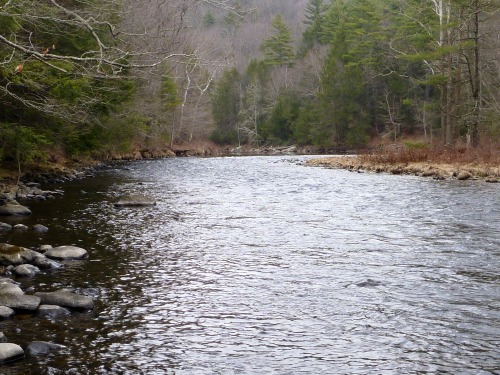
We split up as soon as we got to the river, with the two of them heading to a very long pool, while I went to a "featureless riffle" where I'd done well on previous trips. The shot above does look pretty featureless. I've never tried to wade across it, but I would guess it's 2-3' deep towards the head of the riffle and at least 3-4' deep through most of it.
Other than the rocks at the extreme left, there are no eddies in the entire stretch. Except near the upper left corner of the photo, there aren't even any obvious current seams that you could look at to target your casts. If there is no hatch to bring the fish to the surface, I think it would be hard to fish it successfully with tenkara - or a fly rod for that matter. I've seen several other anglers fish it but I've never seen anyone catch anything.
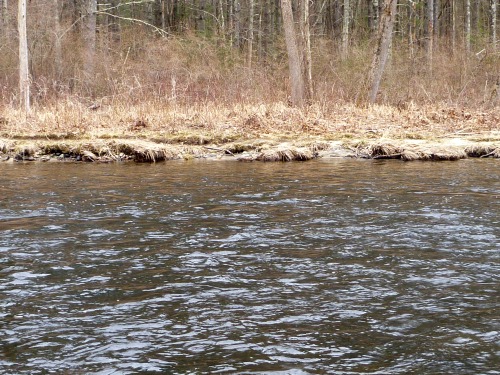
The view of the far bank shows no bank eddies, but it doesn't really matter because you would never be able to reach them anyway, even with a honryu tenkara rod and a very long line.
Even though the water looks (is) featureless, there are fish in there, holding among the rocks on the bottom. I know that because I have caught fish in this spot on several occasions, but only with a keiryu rod and only with a worm. And, I might add, only when I am fishing at the right depth.
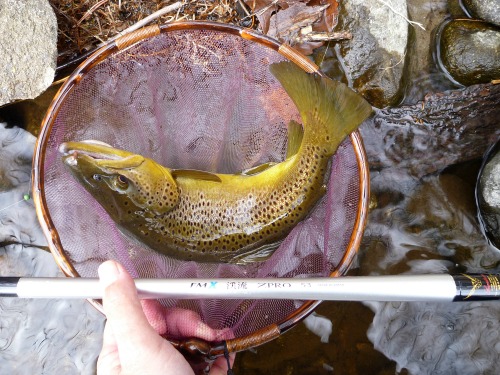 17" brown caught with the new Suntech FMX Keiryu ZPRO 54
17" brown caught with the new Suntech FMX Keiryu ZPRO 54Getting the depth right is critical. I try to set my markers so that the split shot is riding just barely above the rocks on the bottom. That involves adjusting the markers to change the depth whenever I move - not after every step, but fairly frequently. The good news is that it is very easy to slide the markers up or down the line a bit. They are tied in such a way that you can move them but after you do they'll stay put.
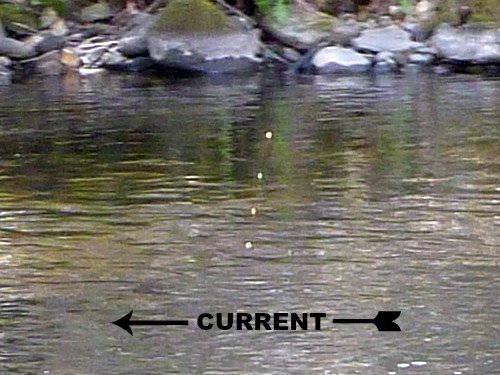
I was finally able to get a reasonable shot of how I set my markers now. Initially I set the markers about 8" apart. Sometimes the top one or two were hard to see because the background behind them was the far bank. The combination of light and shadow and different colors on the bank made it hard to pick out the markers. In the "miracle pool" in Wisconsin I tried a single marker with long tag ends. It worked very well there and was extremely sensitive but I think it may be too sensitive if you are not fishing a quiet pool.
Also, I have become convinced that there is a significant benefit to having at least three markers, the minimum number needed show whether they're in a straight line. I have settled on using four markers about 3" apart, with the lowest one held just a few inches above the surface. I find them easier to spot and watch if they are closer together and if the background is the water rather than the far bank.
After trying several different combinations, I now alternate fluorescent chartreuse and fluorescent orange. Choose the colors, sequence and spacing that YOU find easiest to see.
Try to hold the rig back a little bit. This yields two benefits. First, the flow at the surface is faster than the flow near the bottom, so unless you hold the line back the surface current will pull the bait faster than the current down near the bottom, resulting in an unnatural drift. Second, with the line angled backwards a bit it is much easier to see when the split shot hits a rock or when you get a very subtle bite.
When either of those things happen, the lowest marker stops and the straight line that the markers were in suddenly becomes a curve. That change in shape is very easy to see. This is a major reason to use more than just one or even two markers.
If you are leading the markers with the rod the markers will be angled downstream. If the lowest marker stops, the markers will still be in a straight line. The angle will slowly change, but that slight change in the angle is much harder to notice than seeing a straight line becoming curved.
Also, if it is a rock rather than a fish, it is much easier to free the snag if
the rod is behind the line. Gently lifting the rod as soon as the markers form a curve (almost asking are you a rock or are you a fish?) pulls the line back away from the rock. If the rod is leading the line, lifting the rod to set the hook pulls the split shot or hook into the rock or log. The difference in the number of hooks you'll lose is substantial.
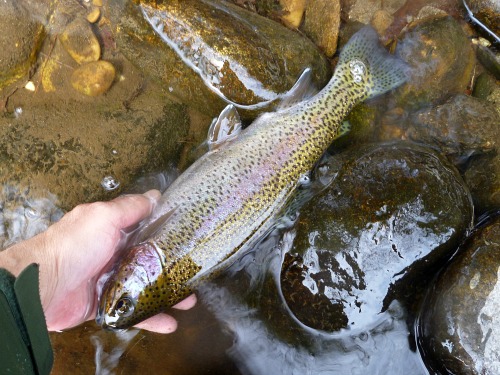
Sometimes, though, the markers don't even budge. When fishing a Killer Bug or wet fly, I have often hooked a fish as I picked up for a new cast. I'm sure the fly looked like an ascending nymph and the fish hit it before it got to the surface.
For the rainbow above it was the same situation. I started to pick up for a new cast and all of a sudden there was a fish on the line. I didn't even need to set the hook, which underscores my previous comments that if there is no slack in your line, a hook set needn't be any more vigorous than picking up for a new cast.
Shortly after I released that fish, the three of us moved to a different spot on the river, one where Adam K and I had done well on previous trips. On Sunday, though, the three of us together did not get even one hit.
After a while we went to a third spot. It was similar to the first - a pool followed by a fairly deep featureless riffle and then another pool. I remember having fished the upper pool a couple times, but I don't remember ever catching anything there. I
mentioned that to Adam after climbing down from the road. He told me that last
time we were there I had caught some fish in the riffle below the pool. (I hate it when my fishing buddy remembers better than I do where I've caught fish.) I shouldn't complain, though. I moved to the riffle and sure enough, caught fish!
It only took a couple casts to
adjust the markers for the correct depth before I hooked a fish. When the markers turned from a straight line to a curve I lifted the rod and got a head shake in return.
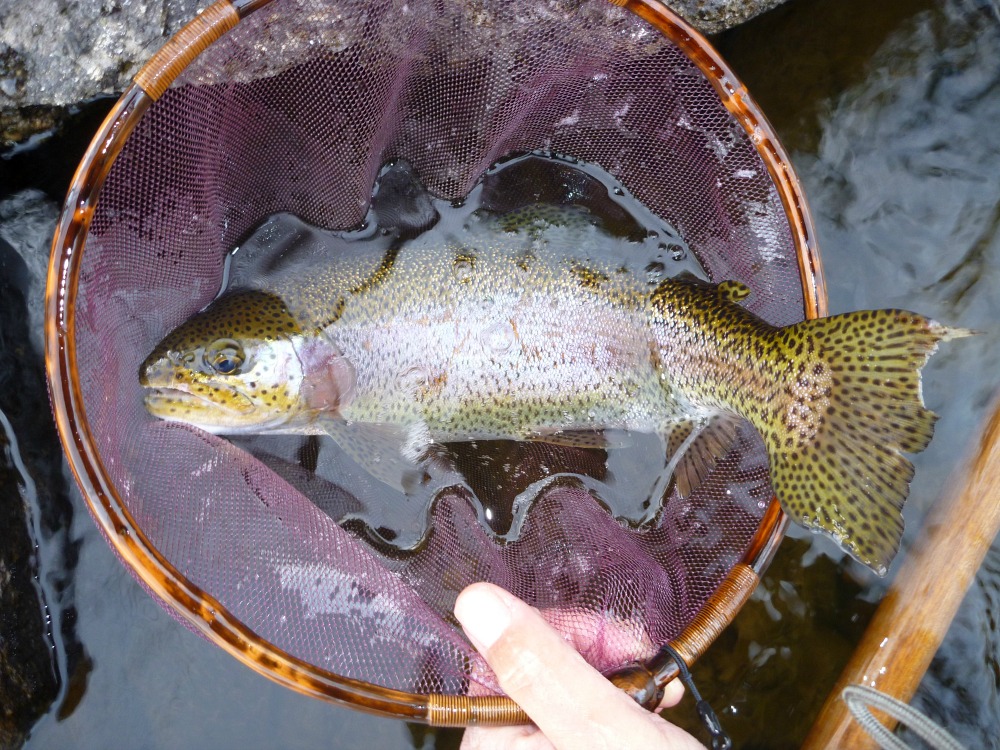
This rainbow has clearly seen better days. The bottom of its tail has been worn off and it looks like something took a bite out of the trailing edge. It was still able to put up quite a fight on the Nissin Air Stage Keihicho 54, though.
The Air Stage was a huge change from the Suntech
Keiryu ZPRO 54 with which I'd caught the first two fish! It is a much stiffer rod throughout its length and very clearly is a tip
flex rod. It is rated for 5X compared to 6X for the ZPRO, but it felt quite a bit more substantial and seemed like it could handle larger fish than other 5X keiryu rods I've
fished (except for the Nissin 2-Way 540ZX stiff, with which people have caught carp). The Air Stage Kiehicho 54 is a lot lighter than the 2-Way 540ZX, though, and is a much nicer rod.
I'll do a page on the Air Stage Kiehicho 54 and 63 before too long.
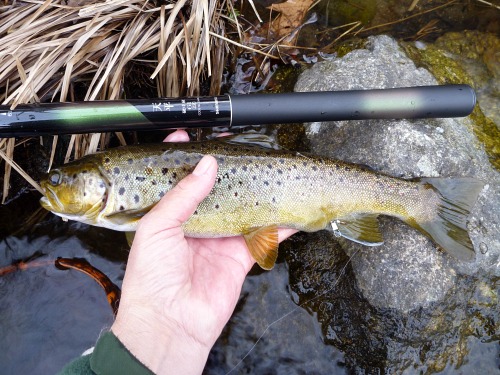
The last fish of the day was a survivor. It had obviously been caught before and had broken the line. There was a bit of line, a snap swivel and a then a bit more line trailing from its vent. I cut the snap swivel off so that it wouldn't catch on anything.
I caught the brown with a Shimano
Tenpyo 61 ZZ which I'd bought used. I rarely buy used rods, but I was curious
about the Tenpyo 61 ZZ and the price was right. It's a nice rod - light and with the versatility of the
three position zoom (54-58-61). I like the rod but I'll probably resell it. I already have a Suntech Keiryu Sawanobori 53 and a Suntech
Kaname 2H 63 so I don't really need it.
It wasn't a many day, but it was a very good day. The
size of the fish, particularly the first one, more than made up for their small number.
Also, after a winter of fishing "artificials only" streams it was nice to get some keiryu time in. I had a conversation not long ago with a friend and fellow tenkara angler who was a little surprised at my interest in fishing with bait. "But you tie such nice flies" was the comment. Well, I'm glad people think that but there's really no connection. Fishing with bait is just another way to fish. I like fishing with the long two handed rods and I like fishing with the extremely light line and yarn markers. The "yes, but you could do that with flies" still reflects a mindset that fishing with flies is somehow better. I just don't see it that way. As I've said for years now, it's just fishing. There's no hierarchy.
TenkaraBum Home > Keiryu Trip Reports > Trip Report 3-27-16
“The bitterness of poor quality remains long after the sweetness of low price is forgotten” - Benjamin Franklin
"Be sure in casting, that your fly fall first into the water, for if the line fall first, it scares or frightens the fish..." -
Col. Robert Venables 1662
As age slows my pace, I will become more like the heron.
Warning:
The hooks are sharp.
The coffee's hot.
The fish are slippery when wet.
Beware of the Dogma
Currently processing orders that were received Mar 8.


